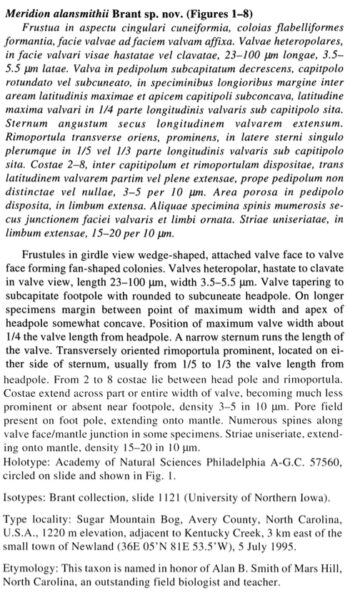Meridion alansmithii
-
Category
-
Length Range20-100 µm
-
Width Range3.5-5.5 µm
-
Striae in 10 µm14-20
-
Contributor
-
ReviewerSarah Spaulding - Jun 2015
Identification
Description
Valves are narrow and linear-clavate, with an attenuated rostrate to subcapitate head pole. A single rimoportula is visible in LM. The rimoportula is positioned near the central sternum, near the widest part of the valve. The sternum is narrow and indistinct. Striae are continuous along the length of the valve. Costae are mostly primary, although secondary costae also are present. Costae number 4-6 in 10 µm and are often not visible near the foot pole.
Autecology
Meridion alansmithii was described from an acidic (4.8-6.4 pH), low conductivity (12-42 µS/cm), and low nutrient temperate mountain wetland in North Carolina (Brant 2003). Samples were collected from squeezes of plants and other algae. Meridion alansmithii has only been reported from wetlands of North Carolina.
-
Size Range, µm3
-
Motility
-
Attachment
-
Habitat
-
Colony
-
Waterbody
-
Distribution
- Learn more about this
Original Description
Frustules in girdle view wedge-shaped, attached valve face to valve face forming fan-shaped colonies. Valves heteropolar, hastate to clavate in valve view, length 23-100 µm width 3.5-5.5 µm. Valve tapering to subcapitate footpole with rounded to subcuneate headpole. On longer specimens margin between point of maximum width and apex of headpole somewhat concave. Position of maximum valve width about 1/4 the valve length from headpole. A narrow sternum runs the length of the valve. Transversely oriented rimoportula prominent, located on either side of sternum, usually from 1/5 to 1/3 the valve length from headpole. From 2 to 8 costae lie between head pole and rimoportula. Costae extend across part or entire width of valve, becoming much less prominent or absent near footpole, density 3-5 in 10 µm. Pore field present on foot pole, extending onto mantle. Numerous spines along valve face/mantle junction in some specimens. Striae uniseriate, extending onto mantle, density 15-20 in 10 µm.
-
AuthorBrant 2003
-
Length Range23-100 µm
-
Width3.5-5.5 µm
-
Striae in 10µm15-20
Citations & Links
Citations
Links
-
North American Diatom Ecological DatabaseNADED ID: 1100
Cite This Page
Burge, D., Edlund, M., Brant, L. (2015). Meridion alansmithii. In Diatoms of North America. Retrieved November 21, 2024, from https://diatoms.org/species/meridion_alansmithii
Responses
The 15 response plots show an environmental variable (x axis) against the relative abundance (y axis) of Meridion alansmithii from all the stream reaches where it was present. Note that the relative abundance scale is the same on each plot. Explanation of each environmental variable and units are as follows:
ELEVATION = stream reach elevation (meters)
STRAHLER = distribution plot of the Strahler Stream Order
SLOPE = stream reach gradient (degrees)
W1_HALL = an index that is a measure of streamside (riparian) human activity that ranges from 0 - 10, with a value of 0 indicating of minimal disturbance to a value of 10 indicating severe disturbance.
PHSTVL = pH measured in a sealed syringe sample (pH units)
log_COND = log concentration of specific conductivity (µS/cm)
log_PTL = log concentration of total phosphorus (µg/L)
log_NO3 = log concentration of nitrate (µeq/L)
log_DOC = log concentration of dissolved organic carbon (mg/L)
log_SIO2 = log concentration of silicon (mg/L)
log_NA = log concentration of sodium (µeq/L)
log_HCO3 = log concentration of the bicarbonate ion (µeq/L)
EMBED = percent of the stream substrate that is embedded by sand and fine sediment
log_TURBIDITY = log of turbidity, a measure of cloudiness of water, in nephelometric turbidity units (NTU).
DISTOT = an index of total human disturbance in the watershed that ranges from 1 - 100, with a value of 0 indicating of minimal disturbance to a value of 100 indicating severe disturbance.

Meridion alansmithii
- Valves elongate, linear-clavate
- Head pole attenuated
- Rimoportula present, near widest part of valve
- Sternum narrow, faint
- Costae present
Valves are elongated and linear-clavate. The head pole is attenuated and subrostrate. A single rimoportula is located distal from the head pole, near the widest part of the valve. Costae mostly primary, with occasional secondary costa. The sternum is narrow and may be difficult to distinguish.
 Diatoms of North America
Diatoms of North America







